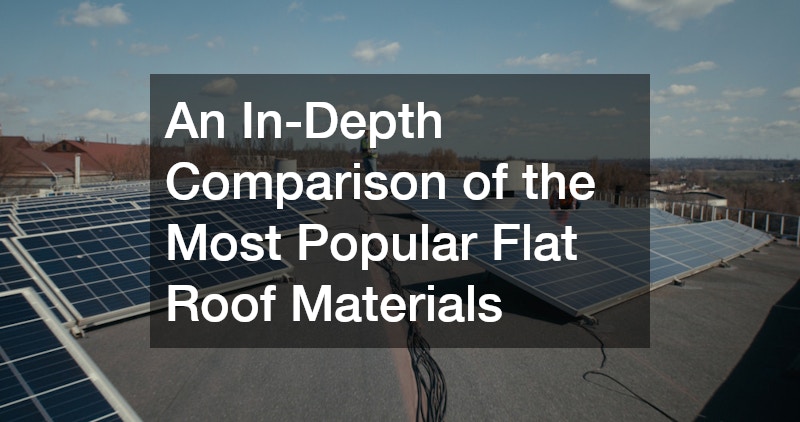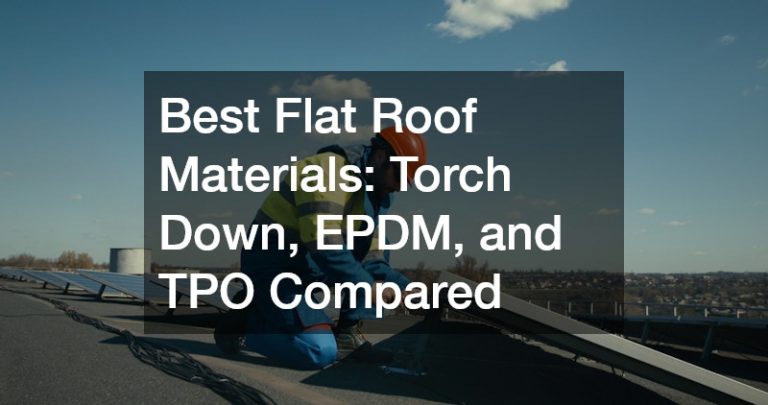This article provides an in-depth comparison of the most popular flat roof materials: Torch Down, EPDM, and TPO. We’ll explore what sets each material apart, helping property owners make informed decisions based on their specific needs. Choosing the right roofing material by the best commercial roofer near me is crucial for ensuring longevity, energy efficiency, and cost-effectiveness of your building.
What are the key differences between Torch Down, EPDM, and TPO?
Composition and Installation
The composition and installation process of flat roof materials are essential considerations for property owners. Torch Down roofing is made primarily of modified bitumen, reinforced with polyester or fiberglass to enhance durability.
The installation process involves applying the material in layers, torching it with an open flame to melt and adhere to the roof.
EPDM, or Ethylene Propylene Diene Monomer, is a type of synthetic rubber that is highly resistant to weathering and abrasion. It is typically installed in large sheets that are adhered to the substrate using adhesive or ballasted with stones. The seamless nature of EPDM installations makes them highly effective at preventing water leaks.
TPO, short for Thermoplastic Olefin, combines the properties of both ethylene and propylene. It is installed using mechanical fasteners and heat-welding seams to ensure a secure, watertight layer. TPO is lightweight, which often simplifies the installation process and reduces labor costs.
Durability and Lifespan
Durability and expected lifespan are critical factors when choosing roofing materials. Torch Down roofs boast a lifespan of 15 to 20 years if properly maintained. Its thick membrane is particularly resistant to punctures and tears, making it ideal for areas with potential mechanical damage.
EPDM roofing is known for its excellent durability, often lasting up to 30 years. Its resistance to UV rays and thermal expansion makes it ideal for varied climatic conditions. The material’s flexibility also contributes to it maintaining integrity under structural shifts or surface movements.
TPO roofs offer a lifespan of about 20 to 25 years and are particularly valued for their resistance to chemical exposure and ultraviolet radiation. This resilience stems from the material’s durable composition. Moreover, TPO’s reflective properties can lead to reduced wear over time.
Cost and Affordability
Cost considerations encompass both initial investment and long-term financial implications. Torch Down roofing generally requires a higher upfront cost due to labor-intensive installation practices involving specialized equipment and skilled workers.
EPDM is often considered more affordable, with pricing markedly influenced by the roof size and installation method. However, its robust nature and extensive lifespan offer significant advantages in reducing long-term maintenance costs and potential repair expenditures.
TPO stands out for its balance between cost-effectiveness and performance. While it may have higher material costs than EPDM, its ease of installation and minimal maintenance requirements tend to offer savings over time. Additionally, its energy efficiency can translate into lower utility bills.
Energy Efficiency
Energy efficiency has become a vital consideration in roofing material selection, driven by environmental sustainability and cost-saving opportunities. Torch Down roofs typically absorb more heat due to their darker surface, which may increase cooling expenses in hotter climates.
EPDM is well-known for its insulating properties, which can moderate internal temperatures and improve overall energy efficiency. The material’s reflective surface, when chosen in white, can contribute further to reducing heat gain during sunny months.
TPO is lauded for its energy-efficient characteristics, primarily due to its bright, reflective surface that diminishes solar heat gain. This quality not only extends the roof’s lifespan but also provides considerable reductions in cooling costs, such as in commercial settings.
Which flat roof material is best suited for different climates?
Torch Down in Extreme Temperatures
Torch Down roofs perform robustly in extreme temperature settings due to their thermal flexibility and strength. In cold climates, their capacity to expand and contract without cracking prevents damage from freeze-thaw cycles.
Conversely, in hot weather conditions, Torch Down’s thicker material can be advantageous, providing an extra layer of insulation. However, its darker surface may absorb more heat, necessitating supplementary cooling solutions or technology to mitigate higher indoor temperatures.
The extreme durability of Torch Down roofing is particularly beneficial for industrial environments where mechanical damage or temperature fluctuations are concerns. It has shown to withstand stark temperature variances better than some lightweight counterparts.
EPDM’s Adaptability to Weather Conditions
EPDM’s adaptability in varying weather scenarios makes it a versatile choice for diverse geographic regions. The material’s rubber composition provides excellent resistance to moisture and can readily shed rain without pooling issues, crucial in rainy environments.
Snowfall-heavy areas benefit from EPDM’s robust flexibility and admirable thermal stability, preventing cracking or stress under heavy loads. Its dark surface absorbs heat in chilly climates, aiding in snow and ice melting.
In hot, sunny climates, selecting a lighter-colored EPDM variant can improve reflectivity and minimize thermal gain. This adaptability makes it suitable for installation across a broad spectrum of weather conditions while retaining efficiency.
TPO’s Reflective Properties for Hot Climates
TPO is highly favored in climates with intensified sunlight exposure due to its reflective surface, which can significantly reduce solar heat absorption. The material’s ability to reflect sunlight keeps the underlying structure cooler, mitigating the urban heat island effect.
In hot climates, TPO roofs are often specifically designed with UV stabilizers to combat degradation due to prolonged sun exposure. These properties make TPO an excellent choice for energy conservation and enhancing comfort within indoor spaces.
The reduction in heat absorption can directly translate into decreased dependency on cooling systems, offering substantial economical and environmental advantages over time. Consequently, TPO is widely recommended for commercial or residential applications in warm weather regions.
Comparative Climate Suitability
Comparing these materials across different climates reveals nuanced performance metrics that guide appropriate selection. Torch Down offers resilience in extreme temperatures, yet may require additional energy solutions in hot climates.
EPDM proves itself a strong candidate through its all-weather adaptability and consistent performance in both wet and cold environments. Its versatility allows it to excel where temperature variation or excessive moisture could pose a threat.
TPO emerges as a preferred solution for maximizing energy efficiency in sunny regions. Its reflective properties aid in heat management, contributing valuable energy savings and sustenance of structural integrity despite punishing sun exposure.
What maintenance is required for each roofing material?
Routine Maintenance for Torch Down
Maintaining a Torch Down roof involves periodic inspections to detect and address minor issues before they evolve into significant problems. Frequent checks for debris accumulation or potential punctures can extend the lifespan of the roof.
Regular cleaning of drainage systems is recommended to prevent water pooling that might compromise the structural integrity of the roof membrane. Professional assessments help identify any needed repair work, such as resealing joints or replacing damaged sections.
Proactive maintenance not only preserves the roof’s condition but also enhances safety by mitigating risks of leaks or structural failures. Ensuring that the membrane remains sealed against water ingress is key to maximizing its durability.
EPDM: Long-Term Care Strategies
Proper long-term care for EPDM roofs can greatly enhance their longevity and effectiveness. Regularly scheduled inspections help identify wear or tears early, allowing for timely and cost-efficient repairs.
Cleaning should involve gentle washing to remove dirt and potential contaminants that might degrade the material’s surface over time. Caution against using harsh chemicals that could undermine the membrane’s pliability is crucial.
Sealants or adhesives used in the installation can degrade due to weather influences; thus, ensuring these are maintained in good condition is essential. Such efforts contribute to sustaining optimal water resistance and insulation properties.
TPO Maintenance Requirements
TPO’s maintenance centers around preserving its reflective capabilities and physical condition. Annual inspections for seam integrity and surface cleansing maintain its primary protective functions.
Ensuring that the TPO surface remains free from debris and residues, which could reduce reflectivity, is important for optimizing energy savings. Specialized cleaning solutions are typically recommended to avoid surface damage.
Prompt repair of punctures or seam failures contributes to avoiding costly water damage. Adopting a proactive maintenance approach ensures TPO roofs remain efficient and effective over their lifespan.
Overall Maintenance Comparison
Comparing maintenance requirements highlights distinct characteristics and demands associated with each material. Torch Down mandates vigilant monitoring due to potential open flame weak points during the torching process.
EPDM’s simplicity, combined with the necessity for gentle cleaning, provides a relatively low-maintenance option, ideal for property owners seeking low-cost longevity. Attention to sealant conditions remains necessary, however.
TPO stands out for maintaining performance ease through routine, comprehensive inspections. Proper care of seams and reflective surface is paramount to its sustained efficiency, rendering it thorough yet straightforward in upkeep.
How do Torch Down, EPDM, and TPO contribute to a building’s sustainability?
Environmental Impact of Torch Down Roofing
Torch Down roofing often faces scrutiny regarding its environmental impact due to its bitumen composition, potentially contributing to fossil fuel dependency. However, its durable nature can minimize frequent material replacement, cutting long-term waste.
Modern Torch Down products strive to incorporate more eco-friendly manufacturing processes and recycled content to reduce their carbon footprint. The impermeability offered by Torch Down can limit heat entry, playing a contributory role in energy conservation.
Balancing Torch Down’s durability with its environmental aspects requires conscientious source selection from manufacturers prioritizing eco-conscious techniques and materials. This balance can make it a viable component in sustainable construction endeavors.
Sustainable Features of EPDM
EPDM roofing contributes positively to sustainability considerations through its long service life and fully recyclable material nature. Its production involves minimal greenhouse gas emissions, catering to environmentally conscious construction practices.
Using EPDM can enhance thermal efficiency within structures, reducing the need for artificial temperature regulation and the associated energy load on HVAC systems. As such, it plays a pivotal role in fostering reduced energy consumption.
Its capability to be manufactured using recycled rubber boosts its eco-friendly credentials, along with options for sustainable disposal or repurposing upon removal. EPDM surfacing options further expand its green benefits.
TPO’s Role in Sustainable Construction
TPO roofing is often considered a leading choice in green construction due to its energy-saving properties and environmental responsibility. Its reflective surface significantly reduces heat absorption, promoting diminished energy use for cooling.
The manufacturing of TPO typically uses fewer harmful chemicals compared to some alternatives, aligning with eco-friendly production goals. It offers a viable alternative in reducing fossil-fuel-based materials within the construction industry.
When enhanced with insulation, TPO can contribute to LEED certification goals and other sustainability standards. This aligns TPO with the priorities of eco-conscious builders seeking to optimize energy efficiency.
Sustainability in Roofing: A Comparative Analysis
Ultimately, each roofing material offers unique sustainability contributions that align with distinct building priorities. Torch Down’s robust lifespan supports waste reduction despite its bitumen origin.
EPDM provides a sustainable solution favoring recycled materials and efficient energy use without compromising integrity. Its long service life aligns with reduced environmental impact and minimized material renewals.
Meanwhile, TPO’s powerful reflectivity and eco-centric manufacturing distinguish it as an energy-efficient choice for sustainable construction pursuits. Such attributes underscore TPO’s place within initiatives seeking to enhance building sustainability.
Conclusion
Selecting the best flat roof material hinges on considerations of climate, budget, maintenance, and sustainability. Torch Down provides robust protection in extreme environments with practiced upkeep, while EPDM offers versatile weather adaptability and exceptional longevity. TPO excels in energy efficiency, making it particularly suited for sun-intensive regions. Property owners must weigh these characteristics against their specific building needs and goals to arrive at an informed roofing decision that balances performance with long-term value.











